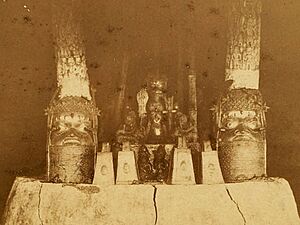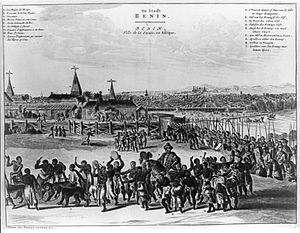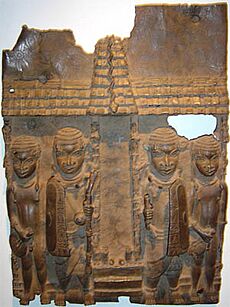Benin Bronzes facts for kids

The Benin Bronzes are a famous collection of thousands of metal sculptures and plaques from the Kingdom of Benin. This kingdom was located in what is now Edo State, Nigeria. The artworks once decorated the royal palace of the king, known as the Oba of Benin.
Created by skilled artists from the Edo people starting in the 1300s, these objects are some of the finest examples of Benin art. The collection includes detailed plaques, portrait heads of kings and queens, animal figures, and jewelry. The plaques, called Ama in the Edo language, show important people and events from the kingdom's history.
Most of these amazing artworks were made of brass, not bronze. The artists used a special technique called lost-wax casting. They got some of their metal by trading with Portuguese merchants in the 1400s and 1500s. They traded for brass bracelets called manillas and melted them down to create their art.
In 1897, a British army attacked and captured Benin City. The soldiers took the thousands of artworks from the palace. These treasures were then sent across the world. Today, the largest collections are in the British Museum in London and in museums in Germany, but many countries are now starting to return them to Nigeria.
Contents
The Story of the Bronzes
The Kingdom of Benin was a powerful and wealthy center of African civilization for centuries. The king, or Oba, ruled from a huge palace in Benin City. This palace was the heart of the kingdom and the center for creating its famous art.
Art in the Kingdom of Benin
The art of Benin was made to honor the Oba, who was seen as a divine or god-like king. Bronze and ivory were royal materials that only the Oba could own. He could, however, give permission for high-ranking chiefs to have items made from them. The art showed the Oba's power, the kingdom's history, and its spiritual beliefs.
A Dutch writer, Olfert Dapper, described the palace in 1668:
"The king's palace or court is a square, and is as large as the town of Haarlem... It is divided into many magnificent palaces, houses, and apartments of the courtiers, and comprises beautiful and long square galleries...resting on wooden pillars, from top to bottom covered with cast copper, on which are engraved the pictures of their war exploits and battles..."
The famous bronze plaques were nailed to the pillars of these galleries. When a king died, his successor would have a bronze head made to honor him. These heads were placed on special altars for ancestors. About 170 of these heads still exist today.
The British Expedition of 1897
In 1897, relations between Benin and the British Empire were tense. A group of British officials and African porters tried to visit Benin City. They were warned not to enter because important religious ceremonies were happening. The British group ignored the warning and continued their journey. They were attacked by Benin warriors, and most of the group was killed.
When news of the attack reached London, Britain organized a large military force called the Benin Expedition of 1897. Led by Admiral Harry Rawson, the soldiers captured and burned much of Benin City.
After the battle, the British soldiers seized all the treasures they could find in the royal palace. Thousands of bronze and ivory sculptures were taken as spoils of war. The British government claimed the attack was a just punishment. However, some historians today believe the raid was planned to remove the Oba and allow Britain to control the region's resources.
The artworks were taken to London. Some were kept by the British Museum, but many were sold to other museums and private collectors in Europe and America.
The Fight for Their Return

Ever since Nigeria gained independence in 1960, its government has officially asked for the Benin Bronzes to be returned. This issue has become a major symbol in the worldwide debate about whether museums should return artifacts to their original homes.
For a long time, very few pieces were returned. However, in recent years, things have started to change. Many museums and universities have agreed that the bronzes were stolen and should go back.
- Universities Lead the Way: In 2021, the University of Aberdeen in Scotland and Jesus College in England were among the first to return bronzes they owned.
- Germany's Big Move: In 2022, Germany announced it would transfer ownership of all 1,100 of its Benin artifacts back to Nigeria. This was a huge step.
- Museums Join In: The Horniman Museum in London, the Smithsonian Institution in the U.S., and others have also returned dozens of bronzes.
In 2023, Nigeria's president declared that all returned bronzes belong to the Oba of Benin and the Royal Family. The Oba plans to display them in a new museum that will be built near the palace grounds in Benin City.
To help track down all the scattered artworks, a project called Digital Benin was launched in 2022. It is an online database with pictures and information on over 5,000 Benin artifacts held in 131 institutions across 20 countries.
A Closer Look at the Art
The art of Benin is known for being very realistic and lifelike compared to other African art from the same time. The artists were masters of their craft, creating detailed and expressive figures.
What the Art Shows
The bronze plaques are like storybooks made of metal. They show many different scenes and people from the kingdom:
- The Oba: The king is often shown as the largest figure in the center, sometimes with assistants on either side. This showed his great importance.
- Warriors and Chiefs: Many plaques show soldiers in armor and important nobles in their ceremonial clothes. Their rank can be identified by the special clothing and symbols they wear.
- Animals: The leopard is a common symbol in the art, as it represents the power and cunning of the Oba.
- The Portuguese: Some plaques show Portuguese traders or soldiers, who can be recognized by their long hair, different clothes, and guns.
The bronze heads made for the ancestral altars were not meant to be exact portraits. Instead, they were idealized images that represented the spirit and power of a past king or queen mother.
How They Were Made

The Benin artists were experts in a technique called lost-wax casting. This is a complicated process:
- First, the artist sculpted a model of the final object out of beeswax.
- Next, they carefully covered the wax model in layers of clay, leaving a small hole.
- The clay was then heated, which caused the wax inside to melt and drain out, leaving a hollow mold.
- Molten (liquid) metal, usually brass, was poured into the hollow clay mold.
- Once the metal cooled and hardened, the artist broke the clay mold, revealing the finished metal sculpture inside.
This method allowed for incredible detail. The artists lived in a special part of the palace and worked only for the Oba, who controlled the valuable materials like brass and ivory. Their amazing skill is what makes the Benin Bronzes some of the most celebrated works of art in the world.
See also
 In Spanish: Bronces de Benín para niños
In Spanish: Bronces de Benín para niños




